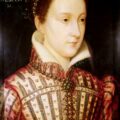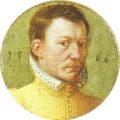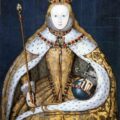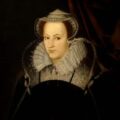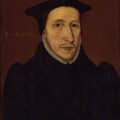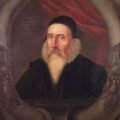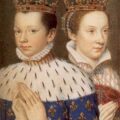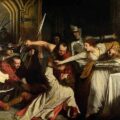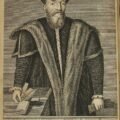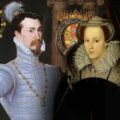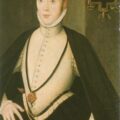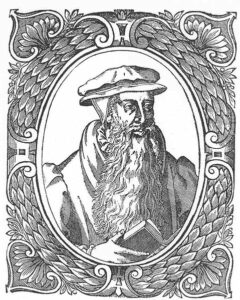
But who was John Knox?
Here are some facts about this fascinating man:-
Born: Between 1505 and 1512 in Haddington, East Lothian, Scotland
Died: 24th November 1572, at his home in Edinburgh
Resting Place: Knox was buried in the cemetery of St Giles’ Cathedral, Edinburgh, where he served as minister.
Family Background: Knox was the son of farmer William Knox and his wife whose maiden name was Sinclair.
Education: It is thought that Knox attended Haddington Grammar School before studying at the University of St Andrews. He studied under John Major, also known as John Mair, the famous Scottish philosopher.
Early Career: After his studies, John Knox entered the priesthood and also worked as a notary. Knox also acted as a tutor to the two sons of Hugh Douglas of Longniddry and the son of John Cockburn of Ormiston, men who were keen Reformers.
Influences: The Reformer and Protestant martyr George Wishart – Knox became good friends with Wishart and acted as his bodyguard. His teacher John Major. John Calvin and Heinrich Bullinger.
The Reformation: We do not know when Knox became a Protestant but we know that he was good friends with George Wishart in the 1540s. When Wishart was arrested and prosecuted for heresy, Knox was also prepared to stand up for his faith and follow suit, but Wishart persuaded him to save himself by concentrating on tutoring. Wishart was burnt at the stake on 1st March 1546 and Knox evaded arrest by seeking refuge at the home of Hugh Douglas. After the murder of Cardinal Beaton, the man who had prosecuted Wishart, the Reformist assassins took possession of the Castle of St Andrews and Knox was able to live their with his pupils. Knox became chaplain of the castle and it was there that he preached his sermon on justification by faith alone and the Bible as the sole authority. He also took part in a debate where he rejected the mass, purgatory and prayers for the dead.
In June 1547, French galleys besieged the castle and the Protestant living there were forced to surrender and become galley slaves. Knox was taken to the Loire Valley in France where, along with other galley slaves, he was forced to celebrate the mass until another prisoner seized a picture of the Virgin Mary and threw her into the water, saying “Let our Lady now save herself: she is light enough: let her learn to swim”. Knox nearly died of illness during his time as a slave, but in February 1549 he was released.
English Exile: After he was released from slavery, Knox fled to England. England was a Protestant country at this time, due to the religious changes made by Edward VI, Thomas Cranmer (Archbishop of Canterbury) and Edward Seymour, the Duke of Somerset. In April 1549, after becoming licensed to work for the Church of England, Knox began work in Berwick-upon-Tweed where he preached Protestant doctrines.
In 1550 Knox became preacher of St Nicholas’ Church in Newcastle-upon-Tyne and in 1551 he was appointed as a royal chaplain. On All Saints Day in 1551 Knox preached a condemnation of John Dudley’s coup d’état but fortunately Dudley saw Knox as an ally, not an enemy. In his first sermon at court after Dudley had taken control, Knox spoke of how the Book of Common Prayer should be changed so that it did not require worshippers to commit what he considered idolatry by kneeling during communion. A compromise was reached when it was declared that no adoration was meant.
Knox was offered the Bishopric of Rochester by Dudley but refused and carried on his work in Newcastle. in February 1553, Cranmer offered Knox the position vicar of All Hallows Church in London, working under the authority of Nicholas Ridley, Bishop of London, but Knox refused. Knox was then ordered to preach in Buckinghamshire, something he did until July 1553, when Edward VI died.
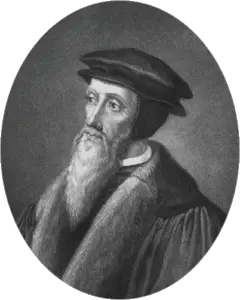
Exile during Mary I’s Reign: In January 1554, Knox and his wife, Marjorie, were forced to flee to the continent after Mary I returned England to the Catholic fold. He travelled to Geneva where he met John Calvin and asked him four questions: 1) Could a minor rule by divine right? 2) Could a female rule and transfer sovereignty to her husband? 3) Should people obey rulers who were ungodly and idolatrous? 4) What party should people follow if they did resist an ungodly ruler. Calvin gave cautious and diplomatic answers and referred Knox to Heinrich Bullinger who did the same but Knox went on to publish “A Faithful Admonition unto the Professors of God’s Truth in England” in July 1555 which was an attack on Mary I and her regime.
In September 1554, Knox was invited to become a minister to a group of English exiles in Frankfurt. He took up the post but found that the congregation was divided into those who favoured a modified version of the Book of Common Prayer and those who favoured a stricter application of it. Knox was able to reach a compromise with his congregation, to keep everyone happy, but there was further trouble when Richard Cox, a man who had helped to write the Book of Common Prayer, arrived in Frankfurt. Knox had written a pamphlet attacking Charles V, the Holy Roman Emperor, and Cox reported him to the authorities for this. Knox was forced to leave Frankfurt in March 1555 and return to Geneva to be a minister there.
In August 1555 he returned to Scotland with Marjorie at the request of Marjorie’s mother, Elizabeth Bowes. He travelled around Scotland preaching and was welcomed by the likes of James Stewart, 1st Earl of Moray, and John Erskine, 17th Earl of Mar. Knox’s Reformist preaching led to him being summoned to a trial at Edinburgh but it was cancelled when he turned up with his influential friends and supporters.
In 1556, Knox returned to Geneva with his wife and mother-in-law to be the minister of the congregation at the Église de Notre Dame la Neuve, a job which saw him preaching three two hour sermons every week. Knox used a liturgy based on John Calvin’s “Formes des Prières Ecclésiastiques”. In 1558, Knox published anonymously his famous “The First Blast of the Trumpet Against the Monstrous Regimen of Women” in which he attacked women rulers such as Mary I and Mary of Guise. Unfortunately, in attacking women rulers, Knox managed to offend Elizabeth I who became Queen of England later that year and who subsequently refused to give him safe passage through England when he travelled to Scotland in 1559.
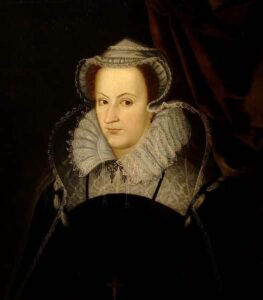
Scotland 1559-1572: Knox arrived back in Scotland in May 1559 where he was declared an outlaw by Mary of Guise. He preached a rousing sermon at Perth, which led to a riot, the gutting of the church and attacks on two local friaries, and another at St Andrews which had the same effect. Mary of Guise threatened the Protestants and sought help from her ally, France, so Knox sought support from William Cecil and England, under the assumed name of John Sinclair. On 24th October 1559, Mary of Guise was deposed and William Maitland of Lethington, her former secretary, defected to the Protestant side. Maitland took charge of the politics side of things so that Knox could concentrate on religion.
The Treaty of Berwick led to England supporting the Scottish Protestants and the Treaty of Edinburgh, which followed the death of Mary of Guise, led to the withdrawal of both the English and Scottish troops from Scotland, something for which Knox gave thanks in a special service at St Giles’ on the 19th July 1560. In early August 1560, Knox was involved in drawing up the Scots Confession, which was approved by Parliament who also abolished the jurisdiction of the Pope in Scotland, forbade the celebration of mass, condemned doctrine and practice which did not adhere to the reformed faith, and asked Knox and other Reformist ministers to organise the new Scottish Kirk (church). Knox and his fellow ministers drew up the Book of Discipline but Parliament delayed over ruling on it because Mary Queen of Scots was due to come back to Scotland. She arrived at Leith on 19th August.
After Mary announced that she would not allow any change in religion in Scotland, Knox protested in a sermon at St Giles’, an act which led to him being summoned to Mary’s presence and being attacked for inciting rebellion and for writing his pamphlet against women rulers. Knox responded by saying that he would accept her rule just as St Paul had accepted that of Nero. Just over a year later, in December 1562, Knox was again summoned to Mary who accused him of speaking irreverently of her and asked him to come to her with differences of opinion rather than preaching against her. Knox, however, ignored Mary’s pleas. Knox was summoned a third time, at Easter 1563, after Protestants apprehended priests in Ayrshire who broke the law by celebrating mass. Mary asked Knox to use his sermons to promote tolerance rather than to incite rebellion. She did, however, agree to bring the priests to justice. At a fourth meeting in June 1563, Mary scolded Knox for preaching against her proposed marriage to Philip II of Spain’s son, Don Carlos, but Knox replied by saying that it was his duty, as her subject, to warn her of dangers to the realm and that he would rather see her weeping, as she was doing, than betray his country. An angry Mary had him thrown out. Knox met Mary for a fifth time later that year when he was called to see Mary and her Privy Council after he had written letters trying to organise a meeting of nobles to defend two burgesses of Edinburgh who had threatened the life of a priest when a crowd had forced their way into a private chapel where mass was being celebrated illegally. Mary regarded Knox’s actions as treasonable but her councillors ruled that he should not be charged.
In June 1564, Knox fell out with Maitland when Maitland told Knox that he should accept Mary Queen of Scots’ authority and be obedient to earthly rulers as preached by Luther and Calvin. Knox argued that Israel was punished for obeying an unfaithful king.
On 29th July 1565, Mary Queen of Scots married Lord Darnley and on the 19th August Knox upset Darnley and caused him to walk out of the church service when he alluded to ungodly rulers. After Darnley’s Protestant supporters murdered Mary’s secretary, David Rizzio, in March 1566, Knox fld to Kyle in Ayrshire where he worked on his “History of the Reformation in Scotland”. Darnley’s subsequent murder and Mary’s marriage to Bothwell, the chief suspect in Darnley’s murder, led to divisions in the Protestant nobles as they tried to figure out what to do. Mary was eventually forced to abdicate and was imprisoned in Loch Leven Castle, while James Stewart acted as regent for Mary’s infant son, James VI. On 29th July 1567, John Knox preached in Stirling at the coronation of James VI and started preaching against Mary and even pushed for her execution. On 23rd January 1570, James Stewart was assassinated and his successor, Matthew Stewart, 4th Earl of Lennox, was shot dead a year later. On 30th April 1571, all enemies of the Queen were ordered by the controller of Edinburgh to leave the city. However, Knox knew the controller and so was offered the option of staying in Edinburgh as a captive in the castle. Knox refused this offer and left the city on the 5th May to travel to St Andrews, where he carried on working on his book and preaching at St Giles’.
Marriage: 1st wife (c1553): Marjories Bowes, niece of Sir Robert Bowes and daughter of Richard Bowes and his wife Elizabeth Aske. Marjorie died in December 1560. 2nd wife (March 1564): Margaret Stewart, the 17 year old of his friend, Andrew Stuart, and a distant relative of Mary Queen of Scots.
Children: Nathaniel and Eleazar who were both born in the late 1550s (c1557 and 1558) in Geneva. Nathaniel’s godfather was William Whittingham and Eleazar’s was Myles Coverdale. Knox had three daughters, Martha, Margaret and Elizabeth, with his second wife, Margaret Stuart.
Death: John Knox died at home just a fortnight after appointing Lawson of Aberdeen to be his successor at St Giles’. He died with his wife reading the First Letter of St Paul to the Corinthians and surrounded by his friends. He was buried in the cemetery of St Giles’ and James Douglas, 4th Earl of Morton and the Regent for James VI, declared at his grave “Here lies one who never feared any flesh”.
Legacy: John Knox is seen as the founder of Presbyterianism. He was survived by his sons, who unfortunately died in their youth, and his three daughters who all married. His young wife, Margaret, went on to marry Andrew Kerr, a man who was involved in David Rizzio’s murder. Knox did not leave much in his will but James Douglas ensured that his family were supported financially by getting Scotland’s General Assembly to agree to continuing to pay Knox’s stipend to Margaret for a year following her husband’s death.
Sources and Further Reading
- John Knox Wikipedia page
- John Knox page at New Advent Catholic Encyclopedia
